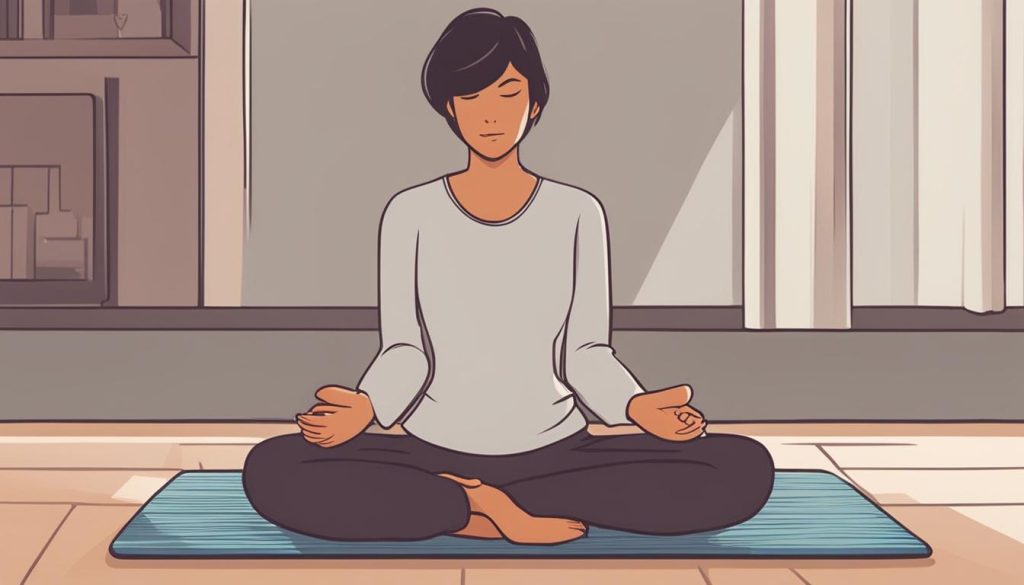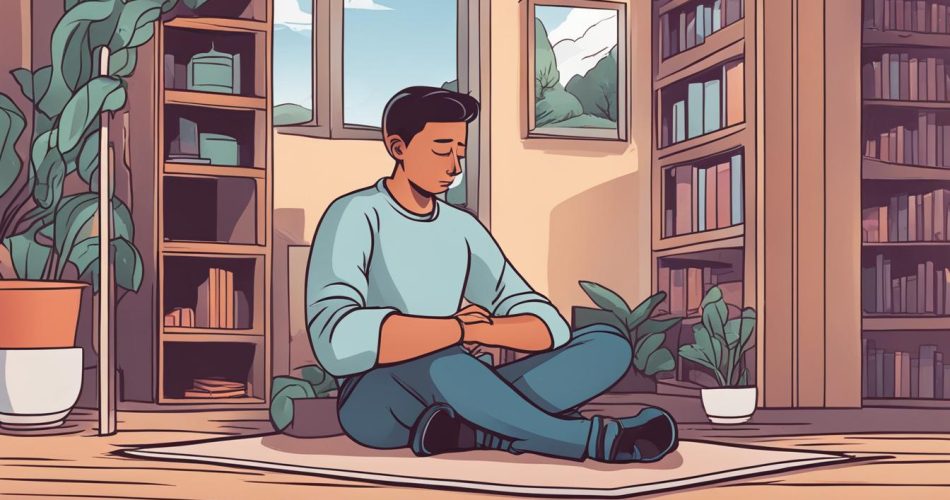Panic attacks can be sudden and overpowering, causing both physical and emotional symptoms. As someone who has experienced panic attacks firsthand, I understand the overwhelming feelings of fear and distress. However, I have learned effective coping strategies that have helped me manage and overcome these challenging moments.
When it comes to managing panic attacks, it’s important to remember that everyone is different, and what works for one person may not work for another. That being said, there are several techniques that have proven effective for many individuals in dealing with panic attacks.
In this article, I will share some of the most effective coping strategies for panic attacks, including deep breathing exercises, finding a peaceful spot, harnessing the power of essential oils, and more. By incorporating these techniques into your routine, you can regain control during a panic attack and reduce the intensity of the symptoms.
Key Takeaways:
- Deep breathing exercises can help regulate your breathing and promote relaxation during a panic attack.
- Finding a peaceful spot can provide mental space and make it easier to focus on coping strategies.
- Essential oils like lavender can have calming effects on the nervous system.
- Using grounding techniques, such as the 5-4-3-2-1 method, can redirect your focus during a panic attack.
- Remember that panic attacks are temporary and will eventually pass.
Remembering That It Will Pass
During a panic attack, it is crucial to remind yourself that these intense feelings are temporary and will eventually subside. It’s important to understand that panic attacks are caused by anxiety and do not pose any physical harm. By reminding yourself of this, you can reduce the intensity of the symptoms and regain a sense of control and calmness.
Panic attacks typically reach their peak within 10 minutes, after which they gradually start to fade away. Acknowledging that a panic attack is a brief episode of concentrated anxiety can help alleviate anxiety and allow you to navigate through it more effectively.
Empowering Yourself with Knowledge
“Knowing that panic attacks are temporary and will eventually fade away provides a sense of relief and helps me stay focused on managing my symptoms.” – Mary, a panic attack survivor
By remembering that panic attacks are time-limited experiences, you can empower yourself to cope more effectively. Remind yourself of this during the midst of a panic attack to counteract any feelings of overwhelming distress. Recognizing that it will pass can bring a sense of comfort and reduce the fear associated with panic attacks.
Practicing Deep Breathing

One of the effective coping strategies for panic attacks is practicing deep breathing exercises. During a panic attack, rapid and shallow breathing is common, which can intensify feelings of anxiety and tension. By consciously focusing on slow and deep breaths, you can regulate your breathing and promote relaxation. Remember to breathe from your abdomen, allowing your stomach to rise and fall with each breath.
One technique that can help reduce anxiety during a panic attack is the 4-7-8 breathing method. This method involves inhaling deeply through your nose for 4 seconds, holding your breath for 7 seconds, and exhaling slowly through your mouth for 8 seconds. Repeat this process a few times, focusing on the sensation of your breath entering and leaving your body.
Deep breathing exercises can help calm your mind and body, reducing the intensity of panic attack symptoms. By bringing your attention to your breath, you can shift your focus away from anxious thoughts and feelings, promoting a sense of calmness and control.
Deep breathing exercises can help calm your mind and body, reducing the intensity of panic attack symptoms.
If you find it challenging to practice deep breathing on your own, there are several resources available that can guide you through breathing exercises. Mobile apps, such as Calm and Headspace, offer guided meditation and breathing exercises specifically designed for anxiety and stress relief. These apps provide step-by-step instructions and soothing audio to help you relax and regain control during a panic attack.
The Benefits of Deep Breathing
Deep breathing exercises have several benefits for managing panic attack symptoms:
- Reduces anxiety and stress levels
- Calms the nervous system
- Lowers heart rate and blood pressure
- Promotes relaxation and a sense of well-being
- Improves focus and mental clarity
Tips for Practicing Deep Breathing
To make the most of deep breathing exercises during a panic attack, consider the following tips:
- Find a quiet and comfortable space where you can sit or lie down.
- Close your eyes or focus on a fixed point to minimize distractions.
- Place one hand on your abdomen and the other on your chest to ensure you are breathing deeply from your diaphragm.
- Take slow, deep breaths, inhaling through your nose and exhaling through your mouth.
- Engage in deep breathing exercises regularly, even when you’re not experiencing a panic attack, to build resilience and incorporate them into your daily routine.
By incorporating deep breathing exercises into your coping strategies for panic attacks, you can effectively manage the symptoms and regain a sense of calmness and control.
Harnessing the Power of Essential Oils
Inhaling certain essential oils, like lavender, can be an effective coping strategy for managing panic attacks and reducing anxiety. Research suggests that lavender oil has calming effects on the nervous system, leading to a decrease in anxiety levels.
To use lavender oil for panic attacks, you can:
- Hold the oil under your nose and inhale gently
- Place a few drops of the oil on a handkerchief and inhale
If lavender doesn’t suit your preference, you can try other essential oils like bergamot orange, chamomile, or lemon. These oils are also known for their anxiety-reducing properties.
| Essential Oil | Properties | How to Use |
|---|---|---|
| Lavender | Calming, reduces anxiety | Inhale directly or use a diffuser |
| Bergamot Orange | Uplifting, relieves stress | Dilute and apply topically or use in a diffuser |
| Chamomile | Soothing, promotes relaxation | Use in a diffuser or apply topically |
| Lemon | Invigorating, enhances mood | Dilute and apply topically or use in a diffuser |
Finding a Peaceful Spot

When experiencing a panic attack, certain sights and sounds can intensify the symptoms, making it more difficult to calm down. That’s why it’s essential to create a peaceful environment that promotes relaxation and aids in coping with panic attacks. One effective strategy is to find a quiet and calming spot where you can retreat to during these episodes.
In this peaceful spot, you can escape from the hustle and bustle of everyday life and create mental space for yourself. It could be a comfortable chair in a cozy corner of your home, a serene park bench surrounded by nature, or even a quiet room where you can shut the door and be in solitude. The key is to find a spot where you feel safe and at ease.
In this quiet and peaceful environment, you can focus on your coping strategies, such as deep breathing, mindfulness, or grounding techniques. The absence of distractions allows you to fully immerse yourself in these practices and regain a sense of control over your body and mind.
Creating a peaceful environment can play a significant role in calming panic attack symptoms and promoting a sense of tranquility. By finding a peaceful spot, you can provide yourself with a sanctuary where you can escape the chaos and find solace in the midst of a panic attack.
Using the 5-4-3-2-1 Method
The 5-4-3-2-1 method is a grounding technique that can be highly effective in redirecting focus away from sources of stress during a panic attack. By engaging the senses, this technique helps reduce other stimuli and provides a sense of grounding, bringing about a calmer state of mind. This method involves a step-by-step process that allows individuals to concentrate on the present moment and immerse themselves in the physical experience, thereby minimizing the intensity of the panic attack.
Here is how the 5-4-3-2-1 method works:
- Look at five separate objects: This can be any five objects in your immediate surroundings. Focus your attention on each object, noticing its color, shape, and texture.
- Listen for four distinct sounds: Pay close attention to the sounds around you. Try to identify four different sounds, such as the chirping of birds, the rustling of leaves, or the soft hum of a fan.
- Touch three objects: Reach out and touch three objects in your environment. Feel the texture, temperature, and weight of each object. Pay attention to the sensation on your fingertips.
- Identify two different smells: Take a deep breath and concentrate on your sense of smell. Try to detect two distinct smells, whether it’s the aroma of freshly brewed coffee or the scent of a nearby flower.
- Name one thing you can taste: Focus on your sense of taste and name one thing you can taste in that moment. It could be the lingering flavor of a mint or the freshness of a slice of lemon.
By following these simple steps of the 5-4-3-2-1 method, you can redirect your attention to the present moment and reconnect with your senses. This technique can help you shift your focus away from the panic-inducing thoughts, providing a sense of relief and control.
Conclusion
Panic attacks can be overwhelming and debilitating, but there are effective techniques and coping strategies that can help individuals regain control and manage their symptoms. By implementing a combination of deep breathing exercises, grounding techniques, essential oil therapy, finding peaceful spots, and practicing the 5-4-3-2-1 method, individuals can develop a toolkit of strategies to combat panic attacks.
Deep breathing exercises play a crucial role in calming the mind and body during a panic attack. By focusing on slow, deliberate breaths and practicing techniques like the 4-7-8 method, individuals can regulate their breathing and reduce anxiety levels.
Grounding techniques, such as the 5-4-3-2-1 method, help redirect focus away from the immediate source of stress and bring individuals back to the present moment. By engaging the senses, this technique provides a sense of grounding and minimizes the intensity of a panic attack.
Additionally, essential oils like lavender can have calming effects on the nervous system, promoting relaxation and reducing anxiety levels. Creating a peaceful environment and incorporating lifestyle changes, like proper hydration and a balanced diet, can also contribute to managing panic attacks more effectively.
Remember, it is essential to prioritize self-care and seek professional help if necessary. Every individual’s journey with panic attacks is unique, and finding the right combination of coping strategies may take time. With persistence and a proactive approach, individuals can develop effective techniques to manage panic attacks and lead a more fulfilling and anxiety-free life.
FAQ
What are some effective coping strategies for panic attacks?
There are several strategies that can help alleviate symptoms and regain control during a panic attack. These include deep breathing exercises, grounding techniques, using essential oils like lavender, finding a peaceful spot, practicing the 5-4-3-2-1 method, engaging in light exercise, trying muscle relaxation techniques, and more.
How can I remember that a panic attack will pass?
It is important to remind yourself that panic attacks are temporary and will eventually subside. By acknowledging that it is a brief episode of concentrated anxiety, one can gain a sense of control and calmness.
What are some techniques for practicing deep breathing during a panic attack?
Deep breathing exercises can be beneficial in managing anxiety and panic attack symptoms. Techniques like abdominal breathing and the 4-7-8 breathing method, which involves inhaling for 4 seconds, holding the breath for 7 seconds, and exhaling slowly for 8 seconds, can help promote relaxation and reduce anxiety during a panic attack.
How can essential oils help with managing panic attacks?
Inhaling certain essential oils, like lavender, can help reduce anxiety and promote relaxation. Research suggests that lavender oil may have calming effects on the nervous system, leading to a decrease in anxiety levels. Other essential oils such as bergamot orange, chamomile, or lemon can also be beneficial.
How can I create a calming environment during a panic attack?
Some individuals find that certain sights and sounds can intensify panic attacks. To create a more peaceful environment, it can be helpful to identify a quiet and calming spot, such as a quiet room or a peaceful outdoor space. This can help create mental space and make it easier to focus on breathing and other coping strategies.
What is the 5-4-3-2-1 method and how can it help during a panic attack?
The 5-4-3-2-1 method is a grounding technique that can help redirect focus away from sources of stress during a panic attack. By engaging the senses and concentrating on looking at objects, listening for specific sounds, touching different objects, identifying smells, and naming tastes, one can minimize the intensity of the panic attack and feel more grounded.
What are some effective techniques for managing panic attacks?
In addition to the strategies mentioned above, other effective techniques for managing panic attacks include repeating mantras, engaging in light exercise, picturing a happy place, taking prescribed medications if recommended by a healthcare professional, sharing your experience with someone you trust, identifying triggers, making lifestyle changes such as proper hydration, a balanced diet, and regular exercise, and seeking professional help or therapies like cognitive-behavioral therapy (CBT) if needed.

